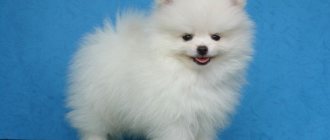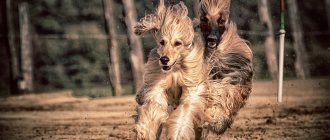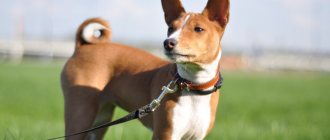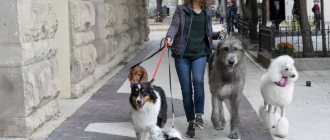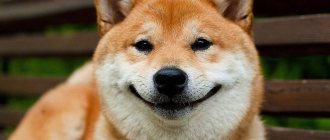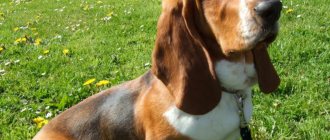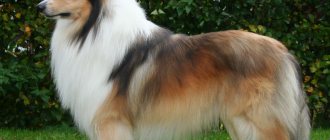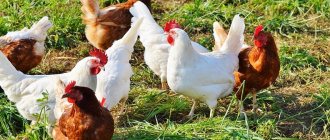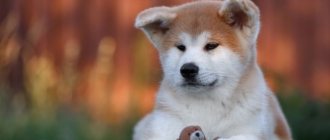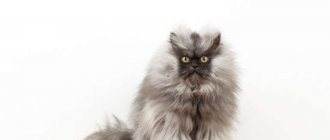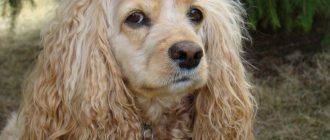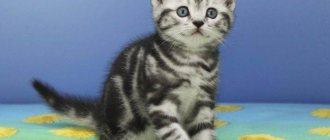For many centuries, the Slovak Chuvach was known to livestock farmers in the Tatras under different names. It was used as a herding and guard dog. Today he is also a family dog, companion and guard with a balanced, strong character, calm and reliable. Needs an experienced owner and requires serious training. Not suitable for life on a chain or in an apartment.
Breed characteristics
Height at withers: males – 62-70 cm, females – 59-65 cm,
Weight: males – 36-44 kg, females – 31-37 kg,
Color: white (yellowish spots near the ears are allowed),
Eye color: dark brown,
Nose color: exclusively black.
General appearance: strong bones, deep chest, long coat, high paws, thick white coat.
Appearance
The Posava Hound has a slightly elongated body. The head is small, neat, with a smooth transition from the forehead to the narrow muzzle. The eyes are quite large, set very close to the forehead, and dark brown or amber in color. The wide nose is dark brown or black, with large nostrils. The ears are set low, thin, hanging, close to the head. The neck is very powerful, wide, of medium length. The chest is well developed and muscular.
The back is strong, with a slight slope towards the tail. The abdomen is elastic and toned. The front legs are straight and widely spaced. The hind legs are powerful, fairly long, with well-developed hock joints. The tail is slightly curved, medium in length, covered with dense hair.
Coat
The Posava Hound has thick, close-lying hair. The average length of the cover is from 2 to 3 centimeters. On the belly and limbs the fur is slightly longer.
Color
The breed standard includes all shades of sand, light brown and red. White spots are allowed on the head, chest, lower paws, tip of the tail, and neck. Solid dark brown color and white spots on the back are not allowed.
History of the breed
The Slovak Chuvach owes its origin to an ancient animal - the Arctic wolf . This species was distributed throughout the continent, but over time it was replaced on the plains by other predators. Arctic wolves remained primarily in mountainous areas.
The distant ancestor bore little resemblance to the modern representative of the breed. People took part in the breeding of the Slovak Chuvaches. This fact is evidenced by at least the white color of the coat.
It is believed that the light dog stood out against the background of nature, and it was easy to distinguish it from the wolves that the Chuvach drove away from the sheep flocks.
Slovakian Chuvaches were bred in the highlands of the Carpathians in Slovakia. The local population called them Tatra Chuvachi , where the first word meant the area where they lived, and the second translated as “sensitive, vigilant .
Close relatives of the Slovak Chuvaches are the Hungarian Kuvasz and the Maremmo-Abrutz Sheepdog. They are united by excellent guard qualities, size and coat color.
The Chuvachi were known only in their homeland. They herded livestock and guarded their owners' homes . Even puppies showed guarding abilities. The life of their owners depended on the household, in which dogs played an important role.
According to one of the official versions, the locals developed trade. People who arrived in the Tatras noticed bright dogs and were surprised at their strength coupled with their unusual beauty. This is how Slovakian Chuvaches ended up on the list of breeds officially registered by Czech veterinarians. In 1964, the breed received recognition from British dog handlers, who drew up the first standard.
Today these dogs also participate in international exhibitions. In total, there are about 3 dozen breed representatives in Russia. Most of them were brought from Slovakia.
Description
Another name for the aboriginal breed is Tatra dogs; previously they were popular in the Tatra Mountains, Carpathians, Alps, and Balkans.
In these areas they have helped herd flocks of sheep since the 17th century, vigilantly protecting the livestock from wolves, bears, lynxes and intruders. There is no exact information about the origin of the defender. There is a scientific version about the relationship between the snowman dog and the polar wolf. Interesting fact
The mountaineer can perfectly distinguish odors at a distance of 30 meters, which is why it is called Chuvach.
Interesting fact
A Balkan man quickly digs food out from under a meter-long layer of snow.
Interesting fact
Emphasizing the vigilance of the aborigine, they say about the lively creature: “Sleeps with half an ear.”
Breed Features
According to dog breeders who keep snow beauties, the breed has not become widespread due to a lack of information about its advantages. These are non-aggressive bodyguards who can valiantly protect the house and all its inhabitants, including other animals.
Acute hearing and a keen sense of smell help quadrupeds do their work. Therefore, the bodyguard senses danger and predators a mile away, that is, before anyone else. In addition, the watchman easily gets along with cats, birds, small and large four-legged animals.
The Balkan is very kind to children, is able to nurse preschoolers, happily shares children's pranks, rushes around the garden or meadow with the boys, cheerfully participating in outdoor games.
But two-year-old foolish children should not be left with a giant, because children at this age have not yet learned the rules of behavior with a wayward “uncle dog” who can inadvertently injure the children.
Distinctive features
Head
Large, oblong. The wide forehead is divided by a clearly visible furrow. The muzzle is decorated with a black movable lobe.
Jaws
Strong with correct bite.
Ears
Triangular, medium-sized. Set on high. Hangs down to jaw level.
Eyes
Oval, small, placed at a medium distance. The iris is brown.
Torso
Massive, muscular. The neck and back are straight. The croup is sloping and powerful. The tail is well covered with elongated hair, set low, touching the hock joints when at rest.
Paws
Straight, muscular, strong.
Wool
The outer coat is 5-15 cm, hard, the undercoat is soft and thick. Strictly white in color, yellowness is allowed only near the ears.
Character
The Highlander has a dual nature. He is vigilant, ferocious towards his enemies and affectionate and sociable with his household. He does not attack first, at first he tries to scare off the stranger with grins, growls, barks, lunges, and only after that he rushes into battle, even if the opponent is stronger than the restless one.
An aborigine, without a command, always guards the house, territory, monitors the safety of household members and family friends. He won’t sleep a wink and won’t calm down until everyone gets together. He becomes attached to all family members, but it is better to be trained by one person who is strong in spirit and experienced in cynology. The Slovak perceives him as a leader.
Without proper upbringing, a Tatra can be stubborn, self-willed, makes decisions on his own, and is cunning in order to avoid following commands. But with a consistent approach:
- learns tricks easily;
- willingly obeys;
- capable of performing the functions of a bloodhound, security guard, border guard;
- protects from insidious “friends”.
Behavior and temperament
Slovak guys are characterized by the following positive qualities:
- Thoughtfulness,
- The ability to stand up for yourself and the owner,
- Devotion,
- Courage,
- Sensitivity,
- Moderate activity.
Negative breed qualities include:
- Waywardness,
- Difficulty in education.
Most guys are sanguine and can show independence in decision making.
Origin
During the First and Second World Wars, almost the entire Chuvach dog population was exterminated. Professor of veterinary discipline Antonina Grudo was able to resurrect. The doctor cultivated the primary purebred nurseries of Chuvaches and overcame all obstacles to public respect. The dude's wool quality is amazing - when it gets dirty in the mud, it's enough to dry it. When you shake it off, everything falls off.
According to the guest, the Slovak Chuvach is a large dog (male - up to seventy centimeters in the mane, female - up to sixty-five centimeters), with a huge head, muscular body and long powerful legs. The dog's weight is small - for a male - up to forty-four kilograms, for a female - up to thirty-seven kilograms. Such a physique helps the quadruped to rapidly increase high speed, intensively carry out attacks and easily evade submission. The Slovakian Dude is a powerful, invincible and excellent dog with balanced nerves. The business language of the guest cannot depict the unique splendor of the fur, hanging in large waves, flowing and sparkling, like snow in the sun.
Slovak dude and man
Such dogs will be excellent helpers on the farm. It is not advisable for beginners who are unfamiliar with serious dogs to have them. Slovak dudes, as guards, must be raised from childhood and clearly understand their place among family members.
Some individuals have a tendency to dominate , which can become a problem in everyday life, given the size of the dog. In this case, the animal shows aggression towards people, sometimes to the point of biting. However, in guard dogs this is not an abnormal behavior, but requires certain training, strength of character of the owner and establishing contacts with the dog.
It’s not worth buying dudes for a child, because he won’t cope with upbringing. However, this breed is tolerant of children's pranks and gets along well in the house with kids. They only show anger towards strangers. Cats and similar living creatures belonging to the owner are an object of protection for the Chuvach people.
The Slovakian Chuvach has a long coat with a thick undercoat, and the climate in the mountains is harsh. This allows the dog to withstand frosts and bad weather in the form of precipitation, and the white coat protects against overheating in the heat. The dudes are brought in to guard the house and are kept on a personal plot, equipped with an enclosure with a booth.
In urban conditions, Slovak guys behave obediently, but with proper restraint and upbringing. There is no evidence of targeted use for hunting.
How to choose a puppy
Are you ready to buy a Slovak dude? An excellent choice, but you need to do it skillfully. When a flock of little “dudes”, charming white buttons, rushes at you, believe me, you will be ready to take them all at once. But you only need to take one thing with you - your dearest one, the one who will become a member of your family for many years.
Slovakian Chuvach puppies are playful, active, curious and simply adorable.
To take or not to take
First, try to clearly formulate for yourself what kind of dog, why you want to get it and whether you can handle it. The questions are by no means idle, because very soon a fluffy polar bear cub will grow into a big white “bear”, which, if not raised correctly, can cause a lot of problems for both you and those around you. Perhaps it would be better to buy, for example, a Labrador?
An adult dog has a strong character, so there may be times when his behavior will have to be adjusted regardless of the purpose for which you are currently choosing a dog: for protection, exhibitions, or just for fun. Are you ready for the fact that you will need to seriously and persistently raise a new member of your pack family?
The white fluffy ball will definitely turn into a large and serious animal, so from the age of two months it’s time to start raising it
What to pay attention to
If you have enough experience and strength to cope with a serious canine temperament, you can purchase a puppy from working parents who have both the appropriate certificates and practical security and protection skills. In any case, you need to look not so much at the documents, but at the puppy’s parents themselves, their external characteristics and behavior - no one has yet canceled heredity.
The physical and psychological state of the baby is of great importance - at the time of moving to a new family, he should be:
- self-confident and active;
- gain age-appropriate height and weight;
- have clear eyes, pink mucous membranes and shiny fur;
- be treated for parasites.
Two-month-old Chuvach puppy is completely ready to go to a new home
It is better to pick up the puppy after the first comprehensive vaccination - after two months. By this age, the main organs of a young dog have already been formed and it is ready to move from its mother’s “nest” to an independent life.
Video: Dude puppies on a walk
Maintenance and care
The Slovakian Chuvach is an unpretentious dog in food. The diet consists of a standard set of products:
- Meat and offal (beef trim, kaltyk, tripe, lung, liver),
- Porridges based on rice and buckwheat,
- Vegetables,
- Dairy products.
A small puppy is served food 4-5 times a day starting from 2-3 weeks of age. The meat is cut into small pieces, the size of which corresponds to the size of the nose.
Porridge with vegetables makes up about 20% of the daily food volume. Cottage cheese, fermented baked milk, kefir and whey – 30%. During puppyhood, practically no by-products are given. According to the recommendations of breeders and veterinarians, mineral and vitamin supplements are included in the diet.
By 8 months the dog is switched to two meals a day . The consumption of carrots is limited, since the white wool acquires a yellowish tint when there is a large amount of this vegetable in food. Raw meat remains the staple food. Pork is considered too fatty and can also be a source of disease.
During cold weather, it is recommended to increase the content of carbohydrates (cereals) if the dog is not obese. It is also useful to add fish oil and olive oil to your food in winter. This improves digestion and the condition of the coat.
Dudes need movement . Even with 24-hour living on the property near the house, dogs are walked at least once a day to maintain physical fitness. Apartment keeping involves walking the puppy as needed, and an adult puppy is walked twice a day for about 2 hours in the fresh air.
The dude loves freedom and space, but calmly tolerates life in an apartment if he has the opportunity to run around the street to his heart’s content . In the courtyard of the house, the dog should have a good-quality booth made of wood or thick plywood, of medium size.
Dude fur care is simple. It is enough to go through the wool every week with a slicker brush and a wide-toothed brush. During the molting period, the dog is combed more actively, once every 2-3 days.
Slovakian dudes are washed when they are heavily soiled or immediately before an exhibition. The dog's coat is self-cleaning , according to owners and breeders. The ears are periodically washed with special products from a veterinary pharmacy, and the claws are shortened with a nail clipper. Whitening shampoos, dry and liquid, are used for washing. After soaping, rinse the wool thoroughly and apply conditioner.
Dry in the summer in the air, and at low temperatures using a hair dryer or compressor. Guys are accustomed to such procedures from childhood, so that the dog is not afraid of water and the noise that comes from a working hair dryer.
Veterinary
Native breeds are usually distinguished by excellent health and trouble-free reproduction of offspring. This is another compelling argument in favor of choosing a Slovakian Dude dog for yourself.
Diseases and vaccinations
The genetics of Slovakian Chuvaches are wonderful - they are very healthy dogs, but recently some of the costs of illiterate breeding have begun to negatively affect the health of the offspring. Fortunately, Chuvaches, unlike many other breeds, do not have specific hereditary diseases and pathologies, but cases of a tendency to allergies have already been recorded (white dogs generally suffer from this more often than all others) and problems characteristic of large breeds - hip dysplasia and gastric volvulus.
Try to initially rule out bad heredity - when choosing a puppy, ask for x-rays to check for the presence of dysplasia in its parents, at least visually assess the condition of the mother’s skin and mucous membranes
Constantly monitor your dog’s physical condition both during the critical growing period and as an adult:
To prevent such a dangerous pathology as gastric volvulus, do not give your dog too large a portion of food at once and do not allow it to actively move for an hour after eating. Carefully monitor the condition of the joints - dysplasia can be not only hereditary, but also acquired as a result of improper cultivation. Support the formation of the growing dog's bones with special supplements - glucosamines and chondroetins; Calcium is also very useful, but it is important to strictly follow its dosage. Avoid putting excessive stress on the joints until the dog reaches one or even one and a half years of age, depending on the size of the individual.
Timely vaccination is an immutable rule for keeping any dog. There are several vaccination schedules for puppyhood. In this sense, different veterinarians have their own preferences. Usually, the first complex vaccinations are given at eight and twelve weeks of age; parasites must be cleared ten days before each vaccination. For the second vaccination, at three months of age, a rabies vaccine is added to the usual complex.
Pregnancy and childbirth
Preparing for the birth of a dog should begin in advance, several months before the expected mating. By this time, the bitch should be in excellent physical and psychological shape. It is very advisable to conduct a comprehensive examination of her health and, above all, check for the presence of various infections that can become dangerous both for the process of pregnancy and childbirth, and for the health of future offspring.
A normal canine pregnancy lasts an average of two months. In the first half of the term, you should not radically change the diet and walking habits of the expectant mother. But moderate physical activity and quality food are certainly very beneficial for her.
Starting from the second month, you should limit your dog from too active games and review its diet. When feeding naturally, it is worth eliminating cereals and crackers, increasing the proportion of protein in everyday food. From the same period, vitamins for pregnant and lactating bitches should be given. A week before giving birth, it is better to reduce the amount of meat consumed by adding fermented milk products to the diet.
The Slovak Shepherd is a gentle and caring mother
Typically, childbirth in a Slovakian Shepherd is quite quick and easy. As a result, up to one and a half dozen charming white fluffies may be born. Ask your dog's breeder how prolific the mother's females are to know what to prepare for. If there is a chance of getting a large litter (8-10 puppies), stock up in advance on bottles with nipples and special formulas for feeding, the so-called bitch's milk. They will have to feed the babies if the bitch can’t cope on her own.
Training
According to the standard, Slovak dudes do not pass mandatory performance tests. However, they are natural guards due to their territorial nature. The dudes look after the site, the house and the rest of the owner’s property. Therefore, instincts must be directed in the right direction. Two common types of training are suitable for this:
- OKD (obedience),
- ZKS (protection and guard).
After passing the exams, the owner receives a diploma. Contrary to the popular opinion about the harm of protective guard service, this course will help determine the working qualities of a particular dog and teach the owner how to handle the pet in extreme situations.
To train a Slovakian dude you will need a lot of patience. Unlike working breeds, these herding and guard dogs think about every action.
You cannot use brute physical force, as this only strengthens the animal’s aggressive behavior and disobedience. In some countries, they practice teaching Slovakian people to select objects by smell.
Character
The Slovakian Dude forms close relationships with his family. He wants to be close and protect her, to be involved in all family adventures. Working dogs live with the herd and protect it; they are used to making decisions on their own.
When protecting their family, they show fearlessness and instinctively protect everyone they consider their own. At the same time, the Slovak dude acts from defense, not from attack. They do not rush at other people's dogs, but prefer to calmly wait for the enemy and then drive him away with the help of barking, bared teeth and throws.
As befits guard dogs, they do not trust strangers and avoid them. Smart, sensitive, observant guys are always aware of what is happening with family members and keep the situation under control.
They bark a lot, thus warning the shepherds about a change in the situation. Loud barking means that the protective instinct has turned on.
If necessary, the dude raises the fur on the back of his neck, and his bark turns into a threatening roar. This roar is frightening, primitive and sometimes it is enough for the enemy to retreat. For all his devotion, the dude dog is willful and independent. They need a calm, patient, consistent owner who is able to train the dog.
It is not recommended to have dogs of this breed for those who have never kept other breeds and for people with a mild character. They are not the most difficult to train, but require experience, like all working breed dogs that make their own decisions.
The owners say that the dudes adore children and are incredibly patient with their antics. Looking after children is a natural job for them.
But it is important that the dog grows up with the child and perceives children's games as games, and not as aggression. But the child must respect her and not hurt her. Naturally, not every Slovak guy has such a character
All dogs are unique and their character largely depends on upbringing, training and socialization.
In addition, Chuvaches are gradually moving from independent, working dogs to the status of companion dogs, and their character changes accordingly.
Health and life expectancy
On average, Slovakian dudes live 13-15 years .
A powerful, but dry and strong body can withstand enormous loads. The fashion for puppies of this breed and show breeding for the sake of appearance have not yet reached the Slovak dudes, so they are not deprived of health.
Common diseases:
- Hip dysplasia,
- Allergies.
It is important to know about the predispositions to diseases of your dog’s ancestors in order to provide decent living conditions and care for your pet. White coat color, along with lightened eye color and nose color, can increase the risk of allergic reactions.
Czechoslovakian Wolfdog
The Czechoslovakian Wolfdog (Czechoslovakian Wolfdog) is one of two FCI-recognized breeds that resulted from crossing a German Shepherd with a wolf. The second breed is the Saarloos Wolfhound, bred in the Netherlands.
The Czechoslovakian Wolfdog is an active, attentive and intelligent dog. She easily becomes attached to her guardian and does not tolerate loneliness very well. The animal treats strangers with a great deal of mistrust. Wolf dogs usually do not show aggression towards children, but when irritated they can growl and even grab a hand with their teeth. Therefore, they should not be left unattended. The Czechoslovakian Wolfdog does not choose one owner, he treats the whole family as his herd. He also has a strong territorial instinct, so he will not allow an uninvited guest into his territory. Despite its high resistance to weather conditions, it is not suitable for living only in the garden - the Czechoslovakian Wolfdog quickly goes wild without human presence and can become dangerous.
Breed photo
A selection of photos of Slovak dudes.
Add a comment Cancel reply
